ISSN ONLINE(2319-8753)PRINT(2347-6710)
ISSN ONLINE(2319-8753)PRINT(2347-6710)
Madheswaran C. K. 1, J. K. Dattatreya 1, P S Ambily 1, Karansingh, P.R 2
|
| Related article at Pubmed, Scholar Google |
Visit for more related articles at International Journal of Innovative Research in Science, Engineering and Technology
Geopolymers are a novel class of materials that are formed by the polymerisation of silicon, aluminum, and oxygen species to form an amorphous 3-D framework structure. Concrete made out of these binder system possess several advantages compared to conventional ordinary Portland cement concretes (OPCCs). Substantial research work has been reported on the impact behaviour of reinforced concrete structural elements whereas similar studies have not been reported on GPCs. This paper describes the experimental and numerical investigation on the behaviour of reinforced GPC slabs under repeated impact loading. The aim is to study the impact behavior of reinforced GPC slabs with and without steel fibers and compare with that of OPCC slabs. The overall dimensions of the GPC slab are 1m x 1m, with 60mm thickness. Finite element modeling of slab was also carried out using ANSYS software. The Solid 65 element and link 8 elements were used to model the concrete slab and Reinforcement respectively. Displacement boundary conditions are applied at the supports. The measured impact load time history is used to excite the structure. Transient dynamic analysis was carried out. The response was obtained in terms of deflection time histories. The peak acceleration of analytical studies showed a pattern similar to that obtained from experimental results. The failure crack pattern of plain and steel fibre reinforced slabs predicted by Finite Element analyses are compared with experimental results. The studies emphasize that by proper design, GPCC can be used in lieu of OPCC for structural components subjected to low velocity impact.
Keywords |
| Geopolymer concrete, fiber reinforced concrete, impact behaviour |
INTRODUCTION |
| Impact is instantaneous application of load. Impact loading could occur in reinforced concrete walls and slabs in certain types of structures, struck by low speed objects accidentally. A structure that is strong for a large static load may fail due to suddenly applied loads of relatively small magnitudes due to impact effect. There have been a number of studies on impact resistance of reinforced concrete members over the past decades. Most of the studies have been carried out on cementitious materials under impact loading. Due to high energy consumption and large CO2 emission of conventional Ordinary Portland Cement Concrete (OPCC), efforts are being made to develop more eco-friendly concrete and one such concrete is Geopolymer Concrete (GPC).To explore the feasibility of the utility of this new concrete for various structural applications, there is a need to study the behaviour under impact load. Improved impact resistance is one of the important attributes of fibre reinforced concrete (FRC). This paper presents an investigation carried out on the impact behaviour of Reinforced GPC panels with and without fibers under repeated impact loading. |
REVIEW OF LITERATURE |
| Jones (1989) et al., have reported the experimental tests on clamped metal beam grillages with rectangular cross-sections and struck transversely by a mass at the centre. The experimental results for the permanent deformations show fair agreement with a quasi-static theoretical rigid-plastic analysis. Rajagopalan (1995) et al., have studied the stiffness degradation of reinforced concrete beams under low-energy impact loading. Nine concrete beams having nominal sectional dimensions of 100mm x 200mm (breadth x depth) and a span of 2300mm are tested under repeated impact loading. The loading is achieved by a freely falling body of a constant mass with a constant height of fall for each test beam. |
| Banthia (1987), Banthia, (1989) et al., Mindness and Banthia (1986) and Ross (1997) have reported the impact resistance of high strength concrete. CRC is an ultra-high-performance concrete with compressive strength around 200 MPa and highly energy-absorbing material with its toughness almost three times that of conventional FRC with steel or polymeric fibres. Under impact, CRC is capable of dissipating much higher energy compared to conventional FRC with polymeric or steel fiber. In this paper behavior of reinforced geopolymer concrete slabs under repeated impact loading is studied. A simplified finite element modeling approach using solid-link elements is proposed to analyses the reinforced geopolymer concrete slab. Nonlinear transient dynamic analysis is carried out. This paper presents the results of behavior of reinforced geopolymer and ordinary Portland cement concrete slab under repeated impact loading. |
EXPERIMENTAL INVESTIGATIONS |
| A. Preparation of test specimens |
| Combination of Fly ash (FA), GGBS (Ground Granulated Blast furnace Slag), Fine aggregates and coarse aggregates, were used for the preparation of GPC mixes. An Alkaline Activator Solution (AAS) consisting of solutions of sodium hydroxide and sodium silicate solutions (molar ratio 2.2) was used to activate the geopolymeric source materials (containing Si and Al). The mixes were produced using a pan mixer 300 kg tilting drum mixer. The mixes had a slump value of at least 100 mm and were easily compactable by needle vibrator. The specimens were demoulded after 24 hours of casting and were cured by storing them at ambient laboratory conditions. Details of the mixes are given in Table 1. Slab specimens of dimensions 1000x1000 and thickness of 60mm were cast using the GPC mix developed at CSIR-SERC, Chennai. Two test specimens each of GPC, OPCC with and without fibres were cast. All the test specimen were reinforced with 2mm welded wire mesh reinforcement in the central portion to prevent punching shear failure at an early stage. Glued Dramics steel fibers of 30mm length were used for FR-GPC specimens. Details of the slab specimens are given in Table.1 |
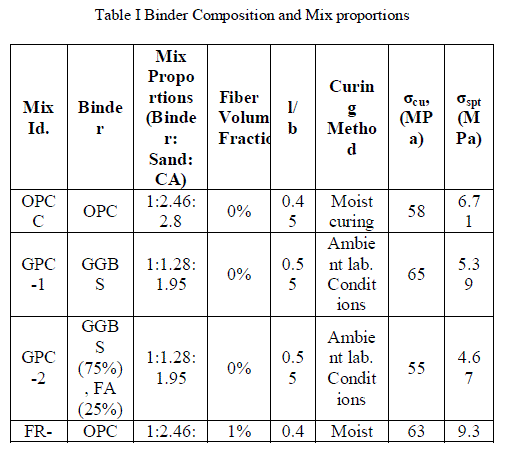 |
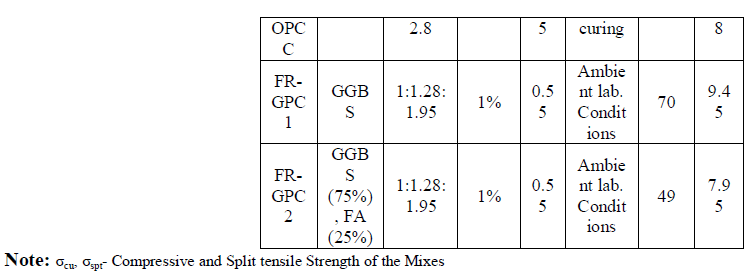 |
| B. Description of test Program |
| Experiments were carried out to study the impact response of OPCC and GPC panels (1000 x 1000 x 60mm) with hinged support conditions as mounted on the supporting frame .Piezoelectric accelerometers were fixed on bottom face of the slab at the centre and quarter points and connected to a TEAC Instrumentation tape recorder through power supply and preamplifier. Electrical resistance strain gauges were fixed on slab surfaces and connected to the tape recorder. Fig.1 shows the experimental set-up for impact test. An instrumented impact hammer (Dharaneepathy (1993) et al., of mass 8.4 kg mounted with a dynamic load cell is connected to the tape recorder through a strain gauge conditioner and an amplifier. The transverse impact is simulated by the free-fall of the instrumented impact hammer at centre of slab. The pulley system with rope and vertical guide enables the hammer to be dropped freely from any desired height vertical over the centre of the slab. The impact force is measured using the dynamic load cell mounted on the hammer. For each drop, the impact load, strain and acceleration signals are recorded using TEAC Instrumentation tape recorder. These analog signals are digitized and acquired using personal computer based data acquisition systems and commercial software. The time-histories of impact load and accelerations of GPC and OPCC slab are presented and discussed. |
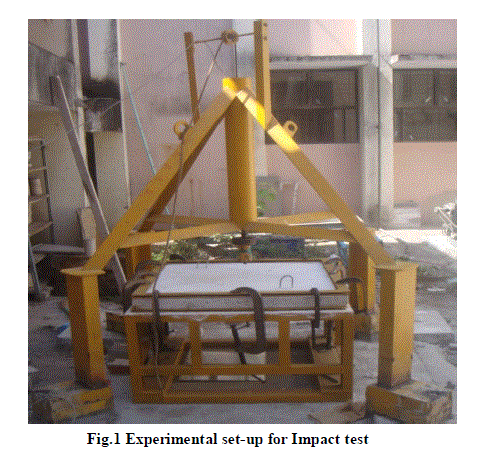 |
TEST RESULTS AND DISCUSSIONS |
| Fig.2a to Fig.2b shows the impact results of all slabs with and without steel fibre. Fig.2a to Fig.2d show the measured impact load time histories for various slabs. It was observed that the measured impact forcing function is triangular in pattern. For a height of drop of 10cm, the peak impact load is 17.5kN. The measured duration of the pulse was about 5milliseconds and the magnitude of the pulse varied from 17.5 kN to 42.5 kN for GPC1 (100% GGBS), 27.5 to 40 kN for OPCC, 17.5 to 32.5 kN for GPC2, 27.5 to 42.5kN for FR-OPCC, 17.5 to 39 kN for FR-GPCC. As the height of drop increases, the measured peak impact load increases and Peak load measured for Fibre reinforced slab is more than the plain slabs. As the height of drop increases, the peak accelerations as well as peak impact load increases but contact duration of pulse decreases. This is mainly due to the fact that as the height of drop increases, contact velocity increases and rebound velocity increases so that the contact duration of pulse decreases. Fig. 3 ) shows the typical acceleration-time histories at the midpoint of a slab for heights of drop of 10cm. The peak acceleration measured are 300 m/s2 for height of drop of 10cm on centre point of plain GPC1 (100% GGBS) slab. Table 2 presents the measured peak values of impact load and accelerations of typical Plain and Fiber Reinforced OPCC and GPC panels at midpoint. |
| Table II Measured Peak Impact load and peak accelerations of slab due to impact at the centre point -Hammer mass=8.4kg |
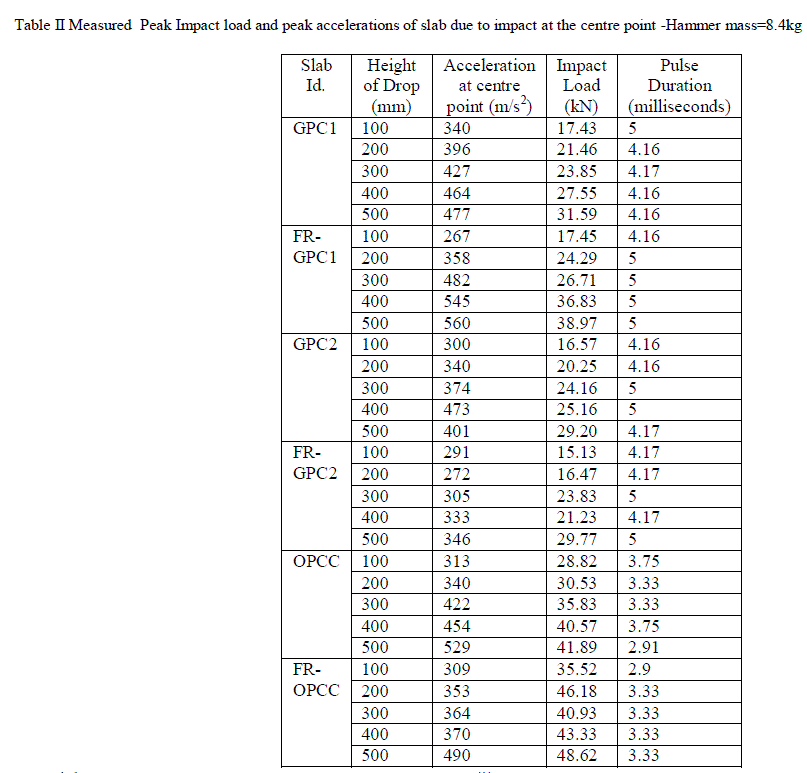 |
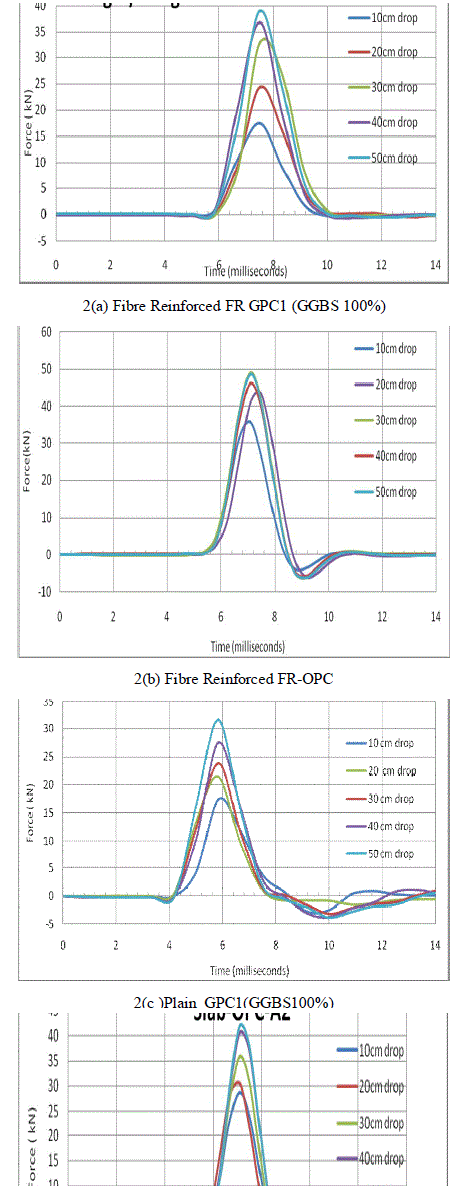 |
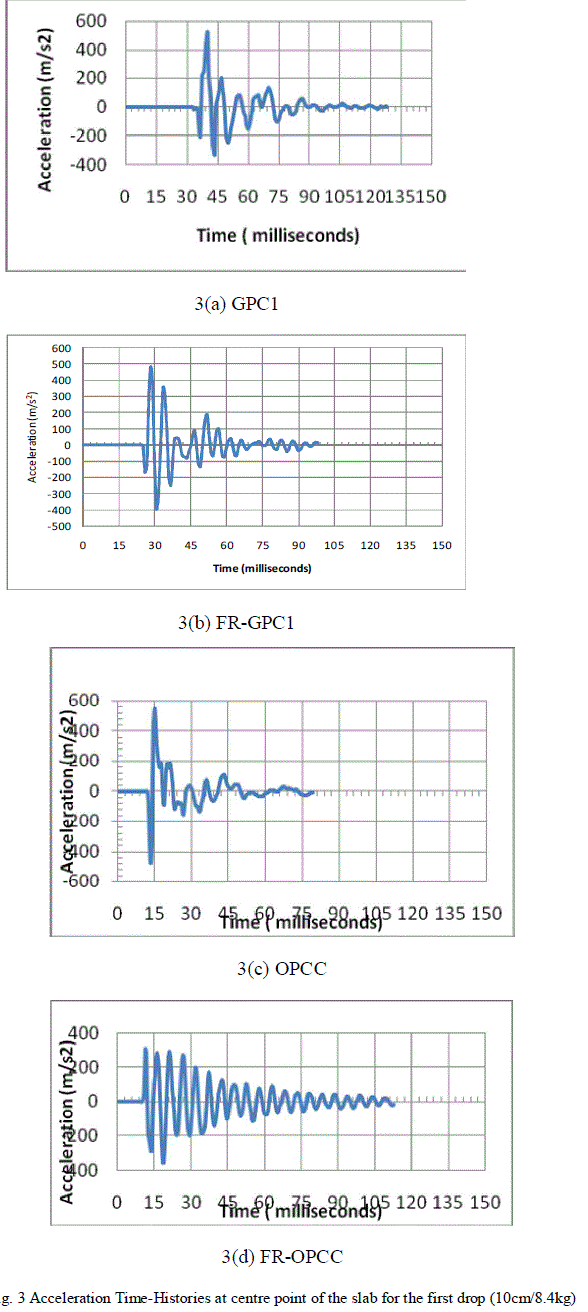 |
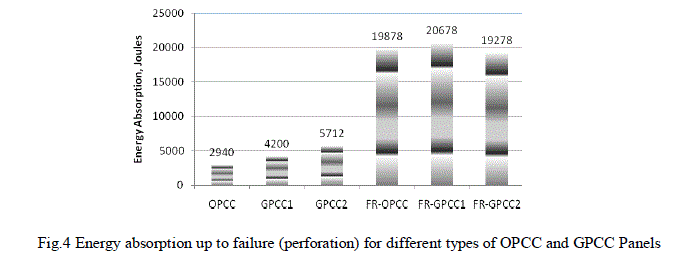 |
| Fig 4 shows the total energy absorption at the failure for the different panels. It is observed that GPC panels absorbed relatively higher energy at both the stages compared to their OPCC counterparts. FR-GPC1 had 4.9 times that of higher energy absorption capacity than Plain GPC1. Fr-GPC2 had 3.37 times that of higher energy absorption than GPC-75 without fibre. Similarly OPCC with 1% fibre showed 6.76 times that of higher energy absorption than its plain counterpart. The marginally higher energy absorption is due to reduced stiffness of GPC and better interface bond with the fibers. Of the two GPC mixes, GPC2 showed lower energy absorption to failure as it is less stiff than GPC1 and is more prone to early scabbing. |
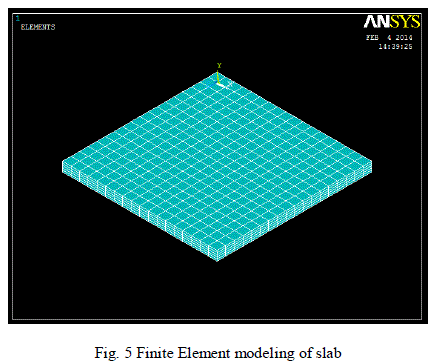 |
| Fig.4 Energy absorption up to failure (perforation) for different types of OPCC and GPCC Panels |
FINITE ELEMENT MODELLING OF SLAB |
| In the present study, reinforced geopolymer concrete slab of size 1m x 1m and thickness 60mm and simply supported boundary conditions is analyzed using finite element method. Diameter of mild steel rod is 2mm and spacing 150mm are used. Thickness of slab is 60mm. Fig.5 shows the Finite Element modeling of geopolymer concrete slab. |
 |
| In this approach, solid plate and link elements are used to model the concrete slab and steel reinforcement. Solid element is defined by eight nodes having three degrees of freedom at each node (x, y and z nodal translations), while link element is a triaxial tension-compression element with three degrees of freedom at each node. Slabs are modeled using 8 nodded solid 65 elements and link8 elements are modeled as reinforcements. Steel behavior is modeled using bilinear stress-strain curve and a multilinear curve is used to characterize the behavior of concrete. Displacement boundary conditions are needed to constrain the model to get a unique solution. To ensure that the model acts the same way as the experimental slabs, boundary conditions need to be applied at where the supports and loadings exist. Loading applied was applied at loading point. Since the whole model was analyzed by the support conditions whereas experimental Uy was restrained to ensure roller support conditions at all ends. Analysis was done using an implicit function and transient dynamic analysis. The loads were applied on the centre of slab using measured impact load time history. The measured impact load time history is shown in Fig.6. |
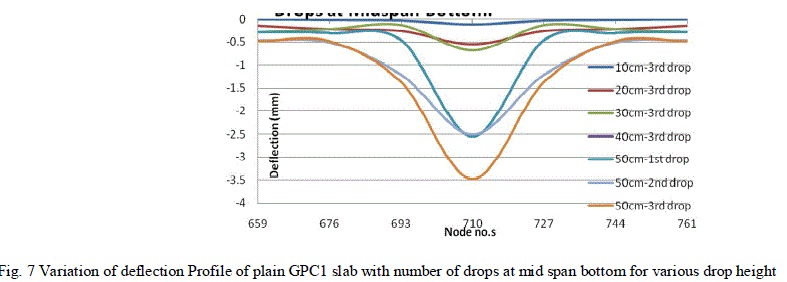 |
| The measured impact forcing function is applied to excite the slab at centre. Nonlinear transient dynamic analysis is carried out with time step of 0.00001 sec. Responses in terms of transverse displacement at centre of slab are obtained as shown in Fig.7. Fig.8 shows the failure crack pattern of bottom of plain and fibre reinforced geopolymer slabs. Fig.9 shows the failure crack pattern of plain slabs by ANSYS analysis. Fig.10 shows the failure crack pattern of fibre reinforced geopolymer slabs by predicted by ANSYS analysis. |
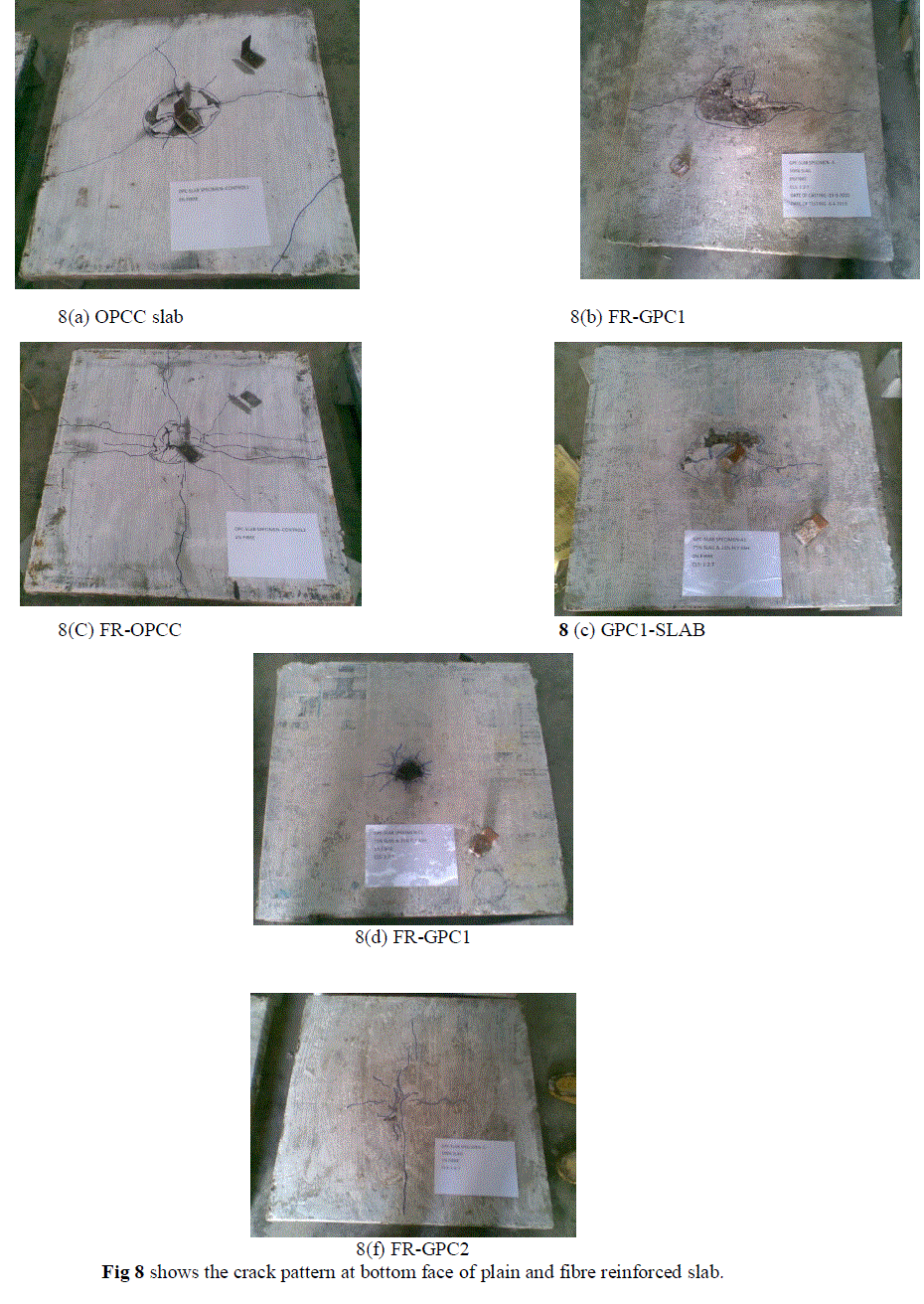 |
| Fig. 7 Variation of deflection Profile of plain GPC1 slab with number of drops at mid span bottom for various drop height |
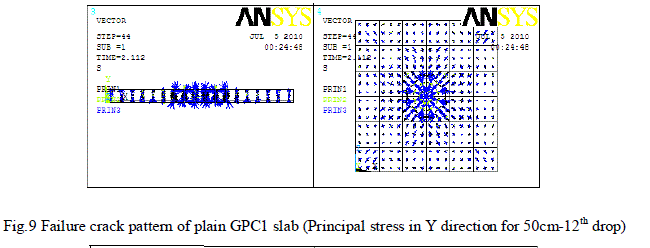 |
 |
CONCLUSIONS |
| Experimental and numerical investigations have been carried out on behaviour of OPCC and GPC concrete slabs with and without steel fiber subjected to repeated impact loading. The impact load and structural acceleration time history were measured. Based on the analyses of the results obtained from this investigation, the following conclusions have been drawn: For a given height of drop and at a specified number of drops, OPCC slabs experienced the highest acceleration while GPC slabs experienced relatively reduced acceleration in case of both plain and fiber reinforced panels. The fiber reinforced slabs experienced lower acceleration compared to their unreinforced counterparts, which could be attributed to the increased damping. The measured duration of the pulse was about 5milliseconds and the magnitude of the pulse varied from 17.5 kN to 42.5 kN for GPC1 (100% GGBS), 27.5 to 40 kN for OPCC, 17.5 to 32.5 kN for GPC2, 27.5 to 42.5kN for FR-OPCC, 17.5 to 39 kN for FR-GPCC. The GPCC slabs because of their lower elastic modulus experience relatively soft impact characterized by reduced peak of the load pulse. The following characteristics of impact responses were observed, the measured peak acceleration and peak impact load increased as the height of drop was increased. The contact duration of pulse decreases as the height of drop increases and depends upon the characteristics, stiffness and material properties of slab. The load time variation under repeated impact loading is essentially triangular in pattern. It is observed that GPC panels absorbed relatively higher energy at both the cracking and failure stages compared to their OPCC counterparts. The plain OPCC and GPC panels failed by perforation while fiber reinforced panels exhibited only scabbing failure. It is observed that GPC panels absorbed relatively higher energy at both the stages compared to their OPCC counterparts. FR-GPC1 had 4.9 times that of higher energy absorption capacity than Plain GPC1. FR-GPC2 had 3.37 times that of higher energy absorption than GPC-75 without fibre. Similarly OPCC with 1% fibre showed 6.76 times that of higher energy absorption than its plain counterpart. The performance of FR-GPCC slab is similar to FR-OPCC slab. Under low energy repeated impact loading there is a progressive degradation of stiffness. Based on the FE analysis, the peak deflection profiles of analytical studies show a similar pattern in accordance to experimental results. The peak accelerations of fibre mixes are less as the mass participating in vibration is less. It was observed that with the increase in number of drops the mid span deflection increases along with the deflection cone radius. The trend is observed as same as experimental and analytical results. It was concluded that the analytical tools of conventional concrete for the impact studies could be well applied to geopolymer concrete. The studies emphasize that by proper design, GPC can be used for structural components subjected to low velocity repeated impact loading. The incorporation of steel fibers, improves impact resistance, energy absorption characteristics, improved toughness, ductility, and improved bond characteristics. |
ACKNOWLEDGEMENT |
| This paper is being published with the permission of the Director, CSIR-Structural Engineering Research Centre, Chennai. The cooperation and guidance received from Dr N Gopalakrishnan, Dr K. Muthumani and Shri Harish of CSIR-SERC, Chennai and the technical staff of Advanced Materials Laboratory and Advanced Seismic Testing and Research laboratory of CSIR-SERC are gratefully acknowledged |
References |
|